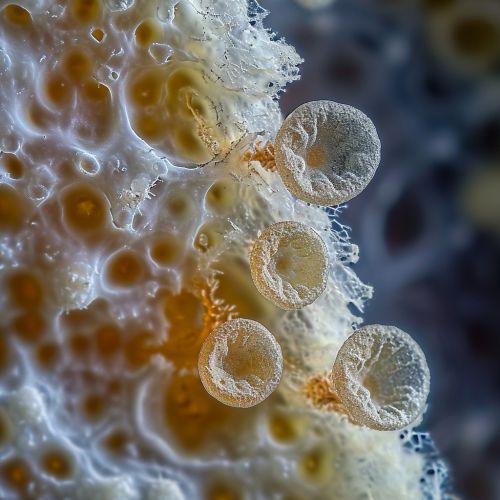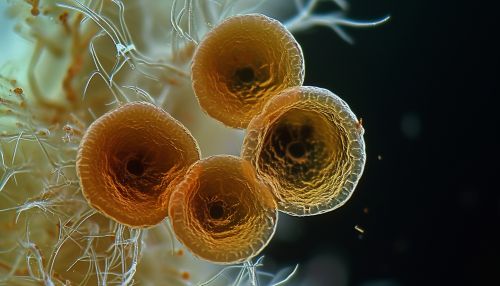Basidium
Overview
The Basidium is a microscopic, spore-producing structure found in certain fungi, particularly those belonging to the groups Basidiomycota and Dacrymycetes. This structure is vital for the sexual reproduction of these fungi, as it is responsible for the production of basidiospores, which are then dispersed into the environment. Basidia come in various shapes and sizes, but are typically club-shaped or cylindrical.


Structure and Formation
The basidium typically begins as a binucleate cell, which undergoes karyogamy to form a diploid nucleus. This nucleus then undergoes meiosis, resulting in four haploid nuclei. Each of these nuclei migrates into its own developing basidiospore, which are borne externally on the basidium. The structure of the basidium varies among different fungi, but it is typically a club-shaped or cylindrical cell with four projections, or sterigmata, on which the basidiospores are formed.
Function
The primary function of the basidium is the production of basidiospores. These spores are produced sexually through the process of meiosis, which ensures genetic diversity among the offspring. Once the basidiospores are mature, they are ejected from the basidium and dispersed into the environment. This dispersal can occur through a variety of mechanisms, including wind, water, and animal vectors.
Types of Basidia
There are several types of basidia, which can be classified based on their structure and the number of spores they produce. These include:
- Tetrasporic Basidia: These are the most common type of basidium and produce four spores. They are found in most basidiomycetes, including the well-known Agaricus bisporus, the button mushroom.
- Bisporic Basidia: These basidia produce two spores and are found in certain groups of fungi, such as the Pucciniomycetes.
- Unisporic Basidia: These basidia produce a single spore and are found in a few groups of fungi, such as the Tremellales.
Basidium in Fungal Life Cycle
In the life cycle of basidiomycete fungi, the basidium plays a crucial role in sexual reproduction. The process begins when two compatible hyphae fuse together, a process known as plasmogamy. This results in a dikaryotic cell, which contains two genetically distinct nuclei. This cell then develops into a basidium, where the two nuclei fuse together in a process known as karyogamy, forming a diploid nucleus. This nucleus undergoes meiosis to produce four haploid nuclei, each of which migrates into a developing basidiospore. Once mature, these spores are released and can germinate to form a new mycelium.
Ecological Significance
Basidia and the basidiospores they produce play a significant role in the ecology of many ecosystems. Many basidiomycetes are saprophytic, meaning they decompose dead organic material. By breaking down this material, they recycle nutrients back into the ecosystem, playing a vital role in nutrient cycling. Other basidiomycetes form mutualistic relationships with plants, aiding in nutrient uptake. Still others are pathogenic, causing diseases in plants and animals.
